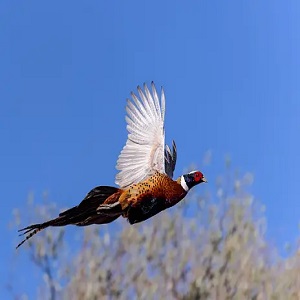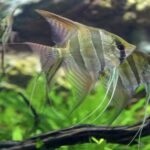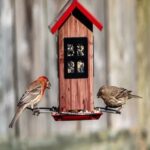Introduction Of South Dakota State Bird
South Dakota State Bird, South Dakota often referred to as the “Land of Infinite Variety,” boasts a rich tapestry of wildlife and natural beauty. Among its many treasures is the majestic ring-necked pheasant (Phasianus colchicus), proudly designated as the state bird of South Dakota.
This striking bird, known for its vibrant plumage and distinctive ringed neck, holds a special place in the hearts of South Dakotans and has become a symbol of the state’s natural heritage.
In this article, we’ll explore some fascinating fun facts about the South Dakota state bird, the ring-necked pheasant, shedding light on its unique characteristics and its significance to the state’s culture and history.
South Dakota State Bird

The South Dakota state bird is the ring-necked pheasant (Phasianus colchicus). It renown for its stunning appearance, this bird features vibrant plumage and a distinctive ringed neck. Making it a cherished symbol of the state’s natural heritage.
South Dakota’s expansive landscapes, from prairies to farmlands, provide an ideal habitat for these pheasants, making them a common sight.
This bird’s popularity also extends to the realm of outdoor sports. As it is a prized target for hunters and an essential element of the state’s rich hunting culture. The ring-necked pheasant stands as a proud emblem of South Dakota’s diverse and vibrant wildlife.
Why is the Ring necked Pheasant the state bird in South Dakota?
The ring-necked pheasant holds the prestigious title of South Dakota’s state bird for several compelling reasons. First introduced to the state in the late 19th century, these birds quickly thrived in the diverse habitats of South Dakota, becoming an integral part of the region’s wildlife. Their abundance not only attracted hunters from across the nation but also contributed significantly to the state’s economy.
Additionally, their vibrant plumage and distinctive appearance make them an iconic symbol of South Dakota’s natural beauty. This combination of historical significance, economic importance, and aesthetic appeal solidifies the ring-necked pheasant’s role as the cherished state bird of South Dakota.
How do South Dakota State Bird behave?
Here are some key aspects of their behavior:
- Diurnal Activity: Pheasants are primarily active during the day, foraging for food and engaging in social interactions. They often roost in trees or dense cover at night for protection from predators.
- Foraging: Pheasants are omnivores, with their diet consisting of seeds, grains, insects, and small invertebrates. They use their strong, scratch-like feet to uncover food from the ground.
- Social Structure: Pheasants are generally social birds, forming loose flocks, especially during non-breeding seasons. Males, known as roosters, are territorial and engage in elaborate displays to establish dominance and attract females.
- Courtship Rituals: During the breeding season, male pheasants display vibrant plumage and engage in impressive courtship rituals. These displays often involve strutting, puffing up their feathers, and making loud calls to attract females.
- Nesting and Reproduction: Female pheasants, called hens, build ground nests concealed in dense vegetation. They lay a clutch of eggs and incubate them.
- Territorial Behavior: Roosters defend territories during the breeding season. They engage in aggressive confrontations with other males to establish dominance.
- Escape Behavior: When threatened, pheasants prefer to run or hide rather than take flight. They can burst into the air with explosive speed if necessary, but they are not strong or sustained fliers.
- Seasonal Movements: Pheasants may exhibit seasonal migrations, moving to different habitats in response to changing food availability and weather conditions.
- Vocalizations: Pheasants known for their distinct calls. Roosters produce crowing sounds, while hens make a variety of clucking and cackling noises.
- Camouflage: Pheasants have cryptic plumage that helps them blend into their surroundings. Providing some protection from predators when they are on the ground.
Do Ring neck Pheasants form communities?
Ring-necked pheasants do exhibit a certain degree of social behavior and can form loose communities, especially during non-breeding seasons. These communities are not as tightly structured as those of some other bird species, but they serve several important purposes:

- Flocking: Outside of the breeding season, pheasants often gather in small groups or flocks. These flocks can include both males (roosters) and females (hens). This behavior provides safety in numbers, as multiple pairs of eyes can help detect predators more effectively.
- Foraging: Group foraging can be advantageous as pheasants scratch and search for food on the ground. Flocking together can help them uncover more food resources and alert each other to the presence of predators.
- Roosting: At night, pheasants may roost in communal areas such as trees or dense cover. This communal roosting behavior provides additional protection against nighttime predators.
- Social Interactions: While not highly social birds, pheasants do engage in social interactions within their flocks. These interactions may include dominance displays, minor skirmishes, and vocalizations.
However, it’s important to note that during the breeding season, male pheasants become territorial and less tolerant of other males. They focus on establishing their own territories and attracting females, which can lead to more solitary behavior during this period. Overall, the formation of pheasant communities is more prominent outside of the breeding season when survival sharing are higher priorities.
State Dessert: Kuchen
South Dakota proudly claims kuchen as its state dessert. Kuchen, which means “cake” in German, reflects the state’s strong German heritage. This delightful pastry consists of a sweet, flaky crust filled with a rich, custard-like filling.
It’s a beloved treat in South Dakota, often enjoyed during family gatherings, holidays, and special occasions. Kuchen’s popularity in the state not only showcases its deliciousness. But also honors the cultural traditions of the early German immigrants who settled in South Dakota.
State Soil: Hudak Soil
South Dakota’s state soil is the Hudak soil, a distinctive and significant component of the state’s natural landscape. Hudak soil is a well-drained, deep soil with a loamy texture that provides an excellent foundation for agriculture. It is particularly renowned for its fertility, making it ideal for crop cultivation, including corn, wheat, and soybeans.
The recognition of Hudak soil as the state soil highlights its vital role in South Dakota’s agricultural heritage and economy. This soil type plays a crucial part in sustaining the state’s agricultural productivity, contributing to its reputation as an essential agricultural region in the United States.
What do Ring neck Pheasants eat?

Ring-necked pheasants are omnivorous birds with a diverse diet. They primarily feed on a variety of plant materials and small invertebrates. Common food items include grains such as corn, wheat, barley, and oats, as well as seeds from grasses and weeds. They also consume a range of insects and other invertebrates like beetles, grasshoppers, caterpillars, and spiders.
During the winter months, pheasants may rely more heavily on grains and seeds as insects become less abundant. Their diet can vary depending on the season and food availability in their habitat. But this omnivorous approach allows them to adapt to different environments and food sources.
Tell me the state bird of South Dakota?
The state bird of South Dakota is the Ring-Necked Pheasant (Phasianus colchicus). This striking bird, known for its vibrant plumage and distinctive ringed neck, holds a special place in the hearts of South Dakotans and has become a symbol of the state’s natural heritage.
State Tree: Black Hills Spruce
The Black Hills Spruce (Picea glauca var. densata), proudly designated as South Dakota’s state tree, is a symbol of the state’s remarkable natural beauty. This evergreen conifer, native to the Black Hills region, displays its resilience and elegance throughout the year. With its slender, dark green needles and conical shape. The Black Hills Spruce is a picturesque addition to the state’s landscape. Its adaptability to various soil and climate conditions makes it a fitting representative of South Dakota’s rugged terrain and enduring spirit. Whether standing tall against harsh winters or offering shade in the summer, this tree exemplifies the strength and vitality of the Mount Rushmore State.
State Fish: Walleye
The Walleye, proudly designated as South Dakota’s state fish, is a beloved symbol of the state’s abundant aquatic resources. This sleek and agile predator, known for its distinctive glassy eyes and olive-golden coloration, thrives in South Dakota’s numerous lakes and rivers. Anglers flock to the state year-round to engage in the thrilling pursuit of catching these prized game fish. The walleye’s delicious, flaky flesh has earned it a special place on the plates of South Dakotans and visitors alike, making it not only a symbol of the state’s natural beauty but also a delectable culinary tradition that brings people together around the table.
State Bird Of Minnesota: 10 Amazing Facts About The Common Loon
State Musical Instrument: Fiddle
The fiddle, often regarded as the soulful heartbeat of South Dakota’s musical heritage, holds the esteemed title of the state’s official musical instrument. With its roots firmly planted in the state’s rich history and cultural traditions. The fiddle plays a prominent role in shaping the musical landscape of South Dakota.
This stringed instrument, similar to the violin but with a unique regional flair. Its hauntingly beautiful melodies have accompanied folk dances, barn gatherings, and storytelling sessions for decades. The fiddle’s spirited tunes evoke a sense of nostalgia, connecting people to their heritage and the prairie landscapes that define the state.
The fiddle’s significance transcends mere entertainment; it serves as a vessel for preserving the state’s history. Through its resonant strings, the stories of pioneers, Native American tribes, and the enduring spirit of South Dakotans are echoed. Fiddlers are esteemed figures in local communities, passing down their musical wisdom and traditions to younger generations.
Every year, South Dakota hosts fiddling contests, festivals, and gatherings that celebrate the instrument’s enduring appeal. These events provide a platform for showcasing the talents of local musicians and reinforcing the fiddle’s role as a cultural touchstone. In essence, the fiddle symbolizes the harmony between South Dakota’s past and present, uniting its diverse population through the universal language of music.
State Grass: Western Wheatgrass

South Dakota’s official state grass, Western Wheatgrass (Pascopyrum smithii), is a testament to the state’s agricultural heritage and its commitment to preserving the natural beauty of its vast prairies. This native grass, known for its resilience and ecological importance, plays a crucial role in shaping the state’s landscape.
Western Wheatgrass thrives across South Dakota’s rolling plains, contributing to the region’s iconic sea of grass. Its deep roots help stabilize soil, preventing erosion and promoting soil health. This hardy grass also provides essential forage for livestock and wildlife, making it a linchpin of the state’s agricultural and ecological systems.
Beyond its practical benefits, Western Wheatgrass serves as a symbol of South Dakota’s enduring spirit. In a state where farming and ranching are deeply ingrained in the culture, this grass represents the perseverance and resilience of the people who call South Dakota home.
Moreover, Western Wheatgrass is a reminder of the state’s natural beauty and its commitment to conservation. South Dakota’s wide-open prairies, adorned with this grass, showcase the state’s dedication to preserving its unique ecosystems and the habitats of countless species.
State Gemstone: Fairburn Agate
The Fairburn Agate, a mesmerizing geological marvel, reigns as South Dakota’s esteemed state gemstone. Renowned for its exquisite bands of vibrant colors, these agates are predominantly discovered in the Fairburn region of South Dakota. These captivating gemstones, formed over millions of years, showcase a spectrum of hues ranging from fiery reds to deep blues and brilliant yellows.
Beyond their aesthetic allure, Fairburn Agates have deep cultural and geological significance, captivating rockhounds and collectors alike. They not only adorn South Dakota’s natural landscape but also hold a cherished place in the state’s history, reflecting the enduring beauty and geological wonders found within the heart of South Dakota.
State Flower: American Pasque

South Dakota’s state flower, the American Pasque, stands as a resilient emblem of the state’s rugged beauty. This exquisite wildflower, scientifically known as Pulsatilla patens, blooms early in the spring, often pushing through lingering snow and frost, signifying hope and renewal after harsh winters. Its delicate, lavender-hued petals and golden center create a captivating contrast against the barren landscape, marking the arrival of warmer days.
The American Pasque not only adds a touch of natural elegance to South Dakota’s prairies and hillsides but also holds cultural significance among indigenous tribes and early settlers. Native American communities regarded it as a symbol of change and new beginnings, while pioneers considered it a sign of resilience in the face of adversity.
As South Dakota’s state flower, the American Pasque serves as a reminder of the state’s enduring spirit, its capacity to thrive under challenging conditions, and its profound connection to the natural world. This resilient bloom encapsulates the essence of South Dakota’s ever-changing but steadfast beauty.
State Fossil: Triceratops
South Dakota’s state fossil, the Triceratops, represents an awe-inspiring chapter in Earth’s prehistoric history. Triceratops, a colossal dinosaur, roamed the ancient landscapes that would one day become South Dakota, captivating scientists and enthusiasts alike. With its massive frill and distinctive three facial horns, the Triceratops is an iconic symbol of the Mesozoic era’s magnificent creatures.
Fossils of this herbivorous giant have been unearthed across South Dakota’s Badlands and Black Hills, unveiling a glimpse into a world that existed millions of years ago. These discoveries not only enrich our understanding of Earth’s ancient ecosystems but also highlight the state’s unique geological heritage. South Dakota’s designation of the Triceratops as its state fossil celebrates the extraordinary creatures that once roamed its ancient terrains and continues to inspire curiosity about the distant past.
State animal: Coyote
South Dakota’s state animal, the coyote (Canis latrans), embodies the state’s untamed spirit and vast, open landscapes. These adaptable and cunning canines have thrived in South Dakota’s diverse terrain for centuries. Known for their distinctive yips and howls that echo through the prairies, coyotes are integral to the state’s natural ecosystem.
Coyotes are resilient survivors, capable of thriving in a variety of environments, from grassy plains to dense forests. They play a vital role in controlling prey populations and maintaining ecological balance. Additionally, they hold cultural significance among indigenous communities in South Dakota, who regard them with respect and reverence.
South Dakota’s designation of the coyote as its state animal honors the creature’s tenacity and its enduring presence in the state’s wild and rugged landscapes, serving as a testament to the state’s commitment to preserving its natural heritage.
State Fossil: Triceratops
South Dakota’s official state fossil, the Triceratops, is a majestic and awe-inspiring relic of Earth’s ancient past. This colossal dinosaur, characterized by its massive frill and three distinctive facial horns, once roamed the very lands that would become South Dakota millions of years later. The Triceratops is an iconic symbol of the Mesozoic era’s remarkable creatures, and its fossils continue to captivate scientists and enthusiasts worldwide.
Many Triceratops fossils have been discovered in South Dakota, particularly in the Badlands and Black Hills regions, providing invaluable insights into prehistoric life. These discoveries help us reconstruct the landscapes and ecosystems that existed in an era long before human civilization.
By designating the Triceratops as its state fossil, South Dakota celebrates its unique geological heritage and deepens our understanding of the ancient world. It also serves as a reminder of the incredible creatures that once roamed its vast and diverse landscapes, contributing to both scientific knowledge and the state’s cultural identity.
Bluebird Meaning: Symbolism And Significance, 7 Amazing Facts
South Dakota State Bird – Ring necked Pheasant
The South Dakota State Bird, the Ring-Necked Pheasant (Phasianus colchicus), is a vivid and beloved symbol of the state’s rich natural heritage. Renowned for its striking appearance, this bird features vibrant plumage, including iridescent green head feathers and a distinctive white neck ring, from which it derives its name. Native to Asia, it was introduced to South Dakota in the late 19th century and has since become an integral part of the state’s culture and identity.
The Ring-Necked Pheasant is not only cherished for its beauty but also appreciated by hunters, as it provides a popular game bird for the state’s outdoor enthusiasts. Every year, South Dakota hosts numerous pheasant hunting seasons, attracting visitors from all over the country.
This resilient bird’s adaptability to South Dakota’s diverse landscapes and agricultural fields reflects the state’s spirit of perseverance and resourcefulness. As the state bird, the Ring-Necked Pheasant embodies South Dakota’s commitment to preserving its natural heritage and celebrating the unique wildlife that graces its open prairies and fertile lands.
FAQs:
What is South Dakota’s state bird?
South Dakota’s state bird is the Ring-Necked Pheasant. It was designated as the state bird in 1943.
Why was the Ring-Necked Pheasant chosen as South Dakota’s state bird?
The Ring-Necked Pheasant was chosen as the state bird of South Dakota because of its significant presence and popularity in the state. It is not only a game bird but also a symbol of South Dakota’s wildlife and outdoor heritage.
What are some fun facts about the Ring-Necked Pheasant in South Dakota?
There are many interesting facts about Ring-Necked Pheasants in South Dakota. For instance, they were introduced to the state in the late 19th century and have since become a vital part of the state’s hunting and tourism industries. They are known for their vibrant plumage and distinctive cackling calls.
Where can I see Ring-Necked Pheasants in South Dakota?
Ring-Necked Pheasants can be found throughout South Dakota, especially in rural areas with suitable habitat such as fields, grasslands, and wetlands. Popular locations for birdwatching and pheasant hunting include state parks and wildlife management areas.
Are there any conservation efforts to protect Ring-Necked Pheasants in South Dakota?
Yes, South Dakota has various conservation programs aimed at protecting and managing Ring-Necked Pheasant populations. These efforts include habitat restoration, hunting regulations, and initiatives to increase pheasant numbers for both conservation and recreational purposes.
![South Dakota State Bird: Ring-Necked Pheasant – Fun Facts & More! [2023]](https://vetpomedix.com/wp-content/uploads/2023/09/South-Dakota-State-Bird-Ring-Necked-Pheasant-–-Fun-Facts-More-2023.jpg)

